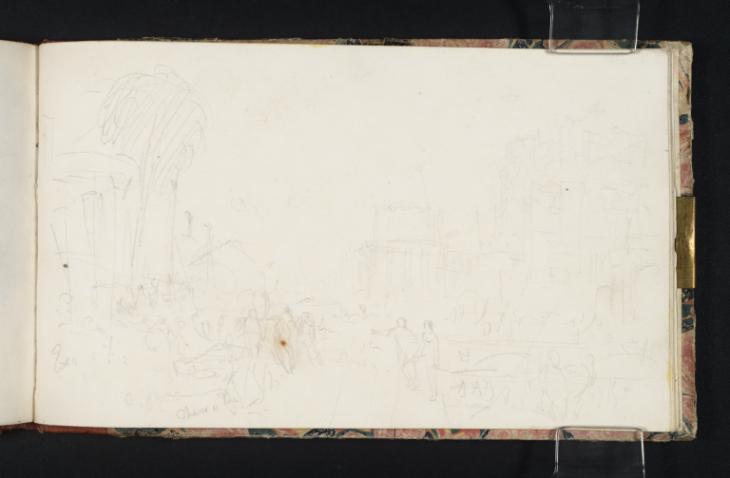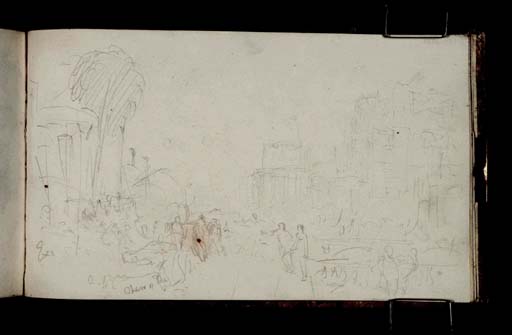Joseph Mallord William Turner Study for a Classical Seaport Subject, Possibly 'Dido Directing the Equipment of the Fleet' c.1823-4
Image 1 of 2
Joseph Mallord William Turner,
Study for a Classical Seaport Subject, Possibly 'Dido Directing the Equipment of the Fleet'
c.1823-4
Joseph Mallord William Turner 1775–1851
Folio 7 Verso:
Study for a Classical Seaport Subject, Possibly ‘Dido Directing the Equipment of the Fleet’ c.1823–4
D17782
Turner Bequest CCIV 7a
Turner Bequest CCIV 7a
Pencil on white wove paper, 111 x 190 mm
Part watermark ‘nard | 20’
Inscribed by Turner in pencil ‘[?Exo]’ and ‘[?Chair of The]’ towards bottom left
Part watermark ‘nard | 20’
Inscribed by Turner in pencil ‘[?Exo]’ and ‘[?Chair of The]’ towards bottom left
Accepted by the nation as part of the Turner Bequest 1856
Exhibition history
2000
Pure as Italian Air: Turner and Claude Lorrain, Tate Britain, London, November 2000–April 2001 (no catalogue).
2002
Turner et le Lorrain, Musée des beaux-arts, Nancy, December 2002–March 2003 (55, reproduced in colour).
References
1909
A.J. Finberg, A Complete Inventory of the Drawings of the Turner Bequest, London 1909, vol.I, p.618, CCIV 7a, as ‘Design for classical composition (“Possibly Dido directing equipment of fleet”)’.
1984
Martin Butlin and Evelyn Joll, The Paintings of J.M.W. Turner, revised ed., New Haven and London 1984, p.149 under no.241.
1990
Kathleen Nicholson, Turner’s Classical Landscapes: Myth and Meaning, Princeton 1990, p.281, fig.147.
2002
Ian Warrell in Warrell, Blandine Chavanne and Michael Kitson, Turner et le Lorrain, exhibition catalogue, Musée des beaux-arts, Nancy 2002, pp.124 no.55, reproduced in colour, p.194, as ‘Study for a Classical Seaport, with the figures of Dido and Aeneas’. c.1823–4.
Inverted relative to the sketchbook’s foliation, this sketch has been developed to quite an elaborate degree, showing a classical seaport populated by a large number of figures and focusing particularly on a gesticulating man and a woman just right of centre in the foreground. Kathleen Nicholson1 has compared the figure of the woman to the statuesque, bare-armed representation of Dido in Dido Building Carthage; or the Rise of the Carthaginian Empire, exhibited at the Royal Academy in 1815 (National Gallery, London);2 the man beside her is presumably her Trojan lover Aeneas.3
Martin Butlin and Evelyn Joll4 have suggested the drawing as relating to the similar subject of Turner’s oil Dido Directing the Equipment of the Fleet, or The Morning of the Carthaginian Empire, exhibited at the Royal Academy in 1828 (Tate N00506).5 They also mention an 1827 ink and chalk drawing (Tate D20818; Turner Bequest CCXXVII a 15)6 which Finberg had recognised as a study for the painting;7 albeit relatively slight, it is close in overall terms to the architectural composition of the painting. The key common feature of the painting and the ink drawing is the open water completely bisecting the two sides of the harbour, in which the sun is reflected, as it had been in Dido Building Carthage. Another related subject, The Decline of the Carthaginian Empire, exhibited at the Royal Academy in 1817 (Tate N00499),8 differs conspicuously in showing a broad stone quay across the foreground, similar to that in the present drawing, as a setting for carefully arranged figure groups.
In the 1828 Dido Directing, the most prominent group of figures is relegated to the middle distance and shown on a much smaller relative scale (the painting is now in very poor condition and its original state is best seen in the rather murky photograph reproduced by Butlin and Joll); as Nicholson notes, it ‘does not follow the sketch’s emphasis, but instead seems to concentrate on architectural display and on an essentially scenic view of a grand harbor.’9 As both the earlier Carthage paintings remained in Turner’s possession, he was able to consider various permutations of their compositions in developing the third; Ian Warrell has also suggested that the present drawing represents a ‘preliminary stage’ in that process.10 The provisional nature of the composition is indicated by the presence of two low suns, side by side towards the left.
This is the last of several such imaginative sketches, starting at folio 1 verso (D17774), under which the sequence is discussed.
Matthew Imms
November 2014
How to cite
Matthew Imms, ‘Study for a Classical Seaport Subject, Possibly ‘Dido Directing the Equipment of the Fleet’ c.1823–4 by Joseph Mallord William Turner’, catalogue entry, November 2014, in David Blayney Brown (ed.), J.M.W. Turner: Sketchbooks, Drawings and Watercolours, Tate Research Publication, April 2015, https://www


